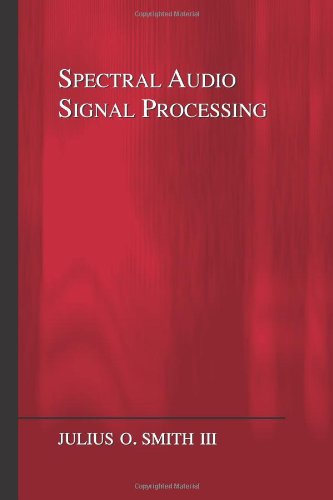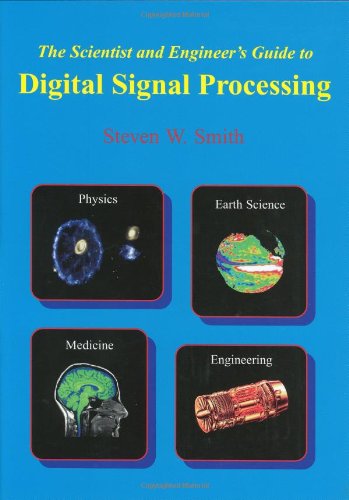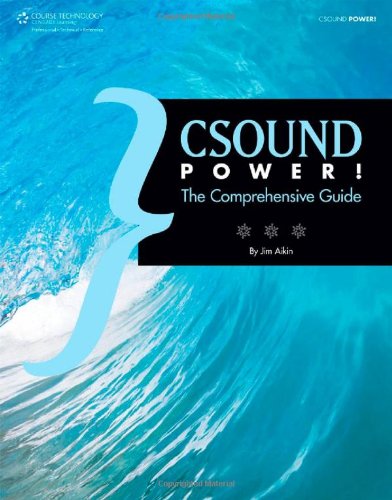
Csound Power!
Jim Aikin
Paperback - 304 pages (January 2012)
Csound, a free, cross-platform, do-it-yourself software solution for sound synthesis and music
production, has been growing in power for more than 25 years. Getting started with this highly
sophisticated system can be a bit daunting for new users. But once you've mastered the basic
concepts, using Csound is nearly as easy as plugging patch cords into a modular synthesizer.
That's where Csound Power! comes in. This definitive reference to Csound provides a
thorough look at the most important features of this powerful program — as well as an
introduction to a few secret features that even experienced Csound users may not know about.
In this hands-on resource, you'll learn how to download and install Csound, how to understand
the structure of a .csd file, and how to use dozens of the most important opcodes in the program.
You'll find concise explanations, hands-on projects, and numerous code samples that will help
you take advantage of Csound's dense, feature-rich environment and make a powerful difference in
your music-production workflow.
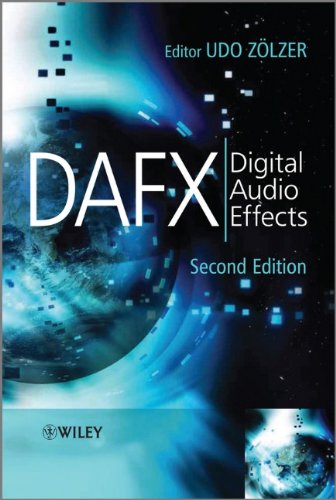
DAFX: Digital Audio Effects
Udo Zölzer (Editor)
Hardcover 2ndd edition - 624 pages (April 2011)
The rapid development in various fields of Digital Audio Effects, or DAFX, has led to new algorithms and
this second edition of the popular book, DAFX: Digital Audio Effects has been updated throughout
to reflect progress in the field. It maintains a unique approach to DAFX with a lecture-style introduction
into the basics of effect processing. Each effect description begins with the presentation of the physical
and acoustical phenomena, an explanation of the signal processing techniques to achieve the effect, followed
by a discussion of musical applications and the control of effect parameters. Topics covered include: filters
and delays, modulators and demodulators, nonlinear processing, spatial effects, time-segment processing,
time-frequency processing, source-filter processing, spectral processing, time and frequency warping musical
signals.
Updates to the second edition include:
• Three completely new chapters devoted to the major research areas of: Virtual Analog Effects, Automatic
Mixing and Sound Source Separation, authored by leading researchers in the field.
• Improved presentation of the basic concepts and explanation of the related technology.
• Extended coverage of the MATLAB scripts which demonstrate the implementation of the basic
concepts into software programs.
• Companion website (www.dafx.de) which serves as the download source for MATLAB scripts,
will be updated to reflect the new material in the book.
Discussing DAFX from both an introductory and advanced level, the book systematically introduces the reader
to digital signal processing concepts, how they can be applied to sound and their use in musical effects.
This makes the book suitable for a range of professionals including those working in audio engineering, as
well as researchers and engineers involved in the area of digital signal processing along with students on
multimedia related courses.
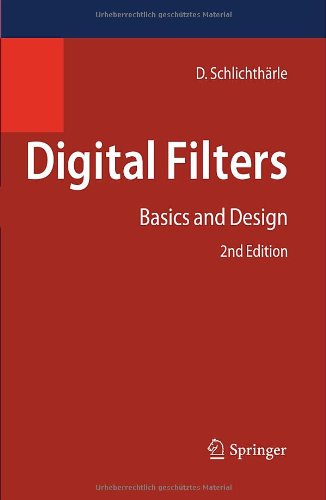
Digital Filters: Basics and Design
Dietrich Schlichthärle
Hardcover 3rd edition - 984 pages (April 2011)
The second, strongly enlarged edition of the textbook gives a substantial insight into the characteristics
and the design of digital filters. It briefly introduces to the theory of continuous-time systems and the
design methods for analog filters. Time-discrete systems, the basic structures of digital filters, sampling
theorem, and the design of IIR filters are widely discussed. The author devotes important parts to the design
of non-recursive filters and the effects of finite register length. The explanation of techniques like
oversampling and noise shaping conclude the book. The author has substantially updated all chapters and
added some important topics like Allpass filters. With an emphasize put on the practical implementation of
theoretical concepts, the book is a reference for advanced students as well as practicing engineers.
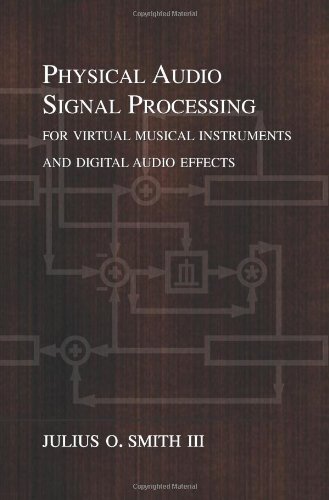
Physical Audio Signal Processing for Virtual Musical Instruments and Digital Audio Effects
Julius O. Smith III
Paperback - 826 pages (December 2010)
This book describes signal-processing models and methods that are used in constructing virtual
musical instruments and audio effects. Specific topics considered include delay effects such as
phasing, flanging, the Leslie effect, and artificial reverberation; virtual acoustic musical
instruments such as guitars, pianos, bowed strings, woodwinds, and brasses; and various component
technologies such as digital waveguide modeling, wave digital modeling, commuted synthesis, resonator
factoring, feedback delay networks, digital interpolation, Doppler simulation, nonlinear elements,
finite difference schemes, passive signal processing, and associated software.
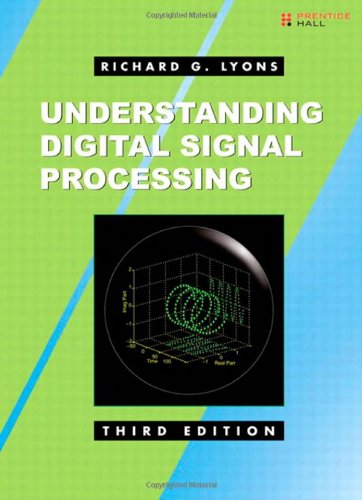
Understanding Digital Signal Processing
Richard G. Lyons
Hardcover 3rd edition - 984 pages (November 2010)
Richard G. Lyons has updated and expanded his best-selling second edition to reflect the newest technologies,
building on the exceptionally readable coverage that made it the favorite of DSP professionals worldwide. He
has also added hands-on problems to every chapter, giving students even more of the practical experience they
need to succeed.
Comprehensive in scope and clear in approach, this book achieves the perfect balance between theory and practice,
keeps math at a tolerable level, and makes DSP exceptionally accessible to beginners without ever oversimplifying
it. Readers can thoroughly grasp the basics and quickly move on to more sophisticated techniques.
This edition adds extensive new coverage of FIR and IIR filter analysis techniques, digital differentiators,
integrators, and matched filters. Lyons has significantly updated and expanded his discussions of multirate
processing techniques, which are crucial to modern wireless and satellite communications. He also presents
nearly twice as many DSP Tricks as in the second edition — including techniques even seasoned DSP
professionals may have overlooked.
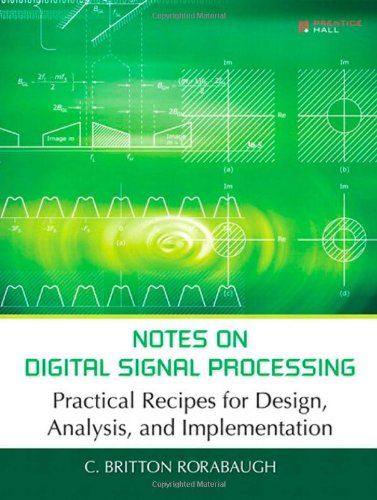
Notes on Digital Signal Processing: Practical Recipes for Design, Analysis and Implementation
C. Britton Rorabaugh
Hardcover - 288 pages (November 2010)
A comprehensive, easy-to-use collection of step-by-step procedures for designing and implementing
modern DSP solutions. Leading DSP expert and IEEE Signal Processing Magazine associate editor
C. Britton Rorabaugh goes far beyond the basic procedures found in other books while providing the
supporting explanations and mathematical materials needed for a deeper understanding.
Rorabaugh covers the full spectrum of challenges working engineers are likely to encounter and delves
into crucial DSP nuances discussed nowhere else. Readers will find valuable, tested recipes for working
with multiple sampling techniques; Fourier analysis and fast Fourier transforms; window functions;
classical spectrum analysis; FIR and IIR filter design; analog prototype filters; z-transform analysis;
multirate and statistical signal processing; bandpass and quadrature techniques; and much more.
Notes on Digital Signal Processing begins with mapping diagrams that illuminate the relationships
between all topics covered in the book. Many recipes include examples demonstrating actual applications,
and most sections rely on widely used MATLAB tools.
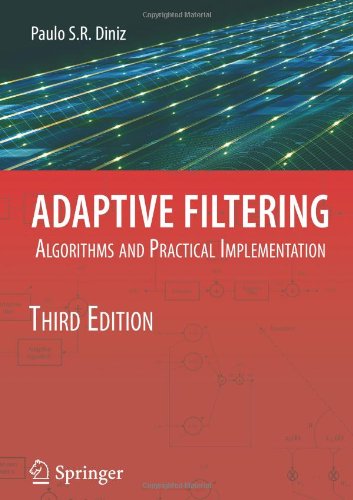
Adaptive Filtering: Algorithms and Practical Implementation
Paulo S. R. Diniz
Paperback 3rd edition - 656 pages (October 2010)
This book presents the basic concepts of adaptive signal processing and adaptive filtering in a concise
and straightforward manner, using clear notations that facilitate actual implementation. Important algorithms
are described in detailed tables which allow the reader to verify learned concepts. The book covers the family
of LMS and algorithms as well as set-membership, sub-band, blind, IIR adaptive filtering, and more. The book
is also supported by a web page maintained by the author.
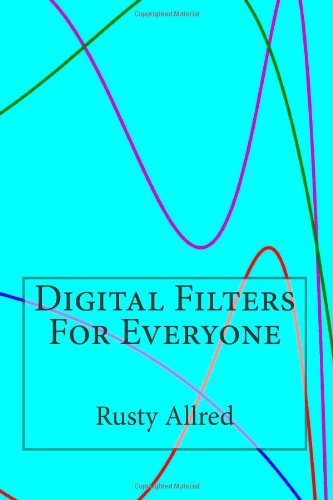
Digital Filters for Everyone
Rusty Allred
Paperback - 174 pages (October 2010)
This book was written to make digital filters more accessible to everyone. Practicing engineers will
appreciate its straightforward approach and the simple formulas that readily lend themselves to real-time
applications. Others will find that digital filter design and analysis is really not as difficult as they
may have thought. For each IIR filter type (Butterworth, Linkwitz-Reilly, Bessel, Chebychev I & II,
Variable Q, Allpass, Equalization, Notch and Shelf), the reader will find one equation for each coefficient.
Plug in what you know � cutoff frequency, sample rate � and the equations will give you the coefficient
values; no expensive software, transforms or complicated manipulations are needed. This approach does have
its limitations. Although the book does explain how to create higher orders by combining lower orders,
there are no equations for IIR filters larger than fourth order. Several FIR methods (Fourier Series and
Frequency Sampling Methods) are included and they do apply to any order. Since elliptical (Cauer) IIR
filters and the Remez and Parks-McClellan algorithms for equiripple FIR design require specialized software
and do not lend themselves to simple formulas, they are not included.
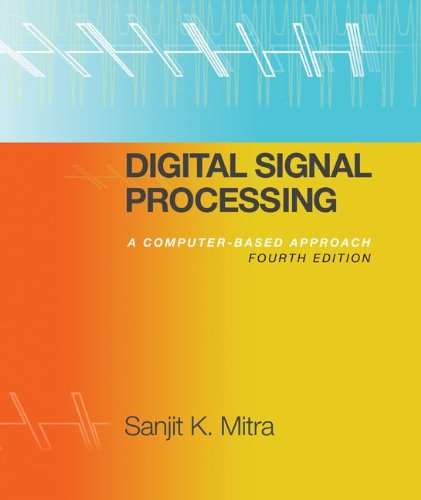
Digital Signal Processing, A Computer Based Approach
Sanjit Mitra
Hardcover 4th edition - 940 pages & CD-ROM (September 2010)
Based on Sanjit Mitra�s extensive teaching and research experience,
Digital Signal Processing, A Computer Based Approach, fourth edition, is
written with the reader in mind. A key feature of this book is the extensive use
of MATLAB-based examples that illustrate the program's powerful capability to solve
signal processing problems. The book is intended for a course on digital signal
processing for seniors or first-year graduate students. This highly popular book
introduces the tools used in the analysis and design of discrete-time systems for
signal processing. A number of changes have been made to the book�s content, based
on reviewer and student comments.
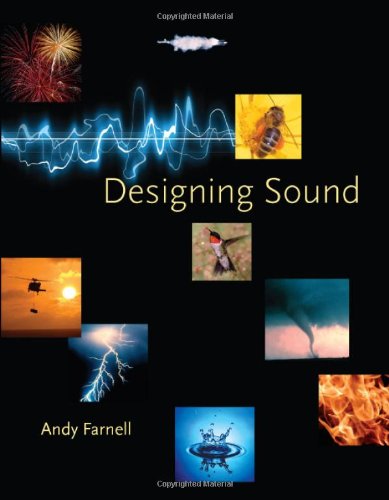
Designing Sound
Andy Farnell
Hardcover 3rd edition - 688 pages (August 2010)
Designing Sound teaches students and professional sound designers to understand and create sound
effects starting from nothing. Its thesis is that any sound can be generated from first principles,
guided by analysis and synthesis. The text takes a practitioner's perspective, exploring the basic
principles of making ordinary, everyday sounds using an easily accessed free software. Readers use
the Pure Data (PD) language to construct sound objects, which are more flexible and useful than
recordings. Sound is considered as a process, rather than as data — an approach sometimes
known as "procedural audio". Procedural sound is a living sound effect that can run as computer
code and be changed in real time according to unpredictable events. Applications include video
games, film, animation, and media in which sound is part of an interactive process. The book takes
a practical, systematic approach to the subject, teaching by example and providing background
information that offers a firm theoretical context for its pragmatic stance. Many of the examples
follow a pattern, beginning with a discussion of the nature and physics of a sound, proceeding
through the development of models and the implementation of examples, to the final step of producing
a Pure Data program for the desired sound. Different synthesis methods are discussed, analyzed, and
refined throughout. After mastering the techniques presented in Designing Sound, students will be
able to build their own sound objects for use in interactive applications and other projects.
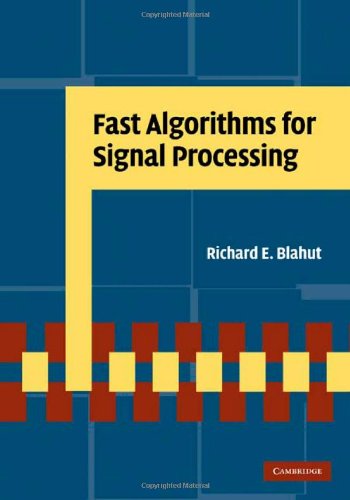
Fast Algorithms for Signal Processing
Richard E. Blahut
Hardcover - 466 pages (August 2010)
Efficient signal processing algorithms are important for embedded and power-limited applications
since, by reducing the number of computations, power consumption can be reduced significantly.
Similarly, efficient algorithms are also critical to very large scale applications such as video
processing and four-dimensional medical imaging. This self-contained guide, the only one of its kind,
enables engineers to find the optimum fast algorithm for a specific application. It presents a broad
range of computationally-efficient algorithms, describes their structure and implementation, and compares
their relative strengths for given problems. All the necessary background mathematics is included and
theorems are rigorously proved, so all the information needed to learn and apply the techniques is
provided in one convenient guide. With this practical reference, researchers and practitioners in
electrical engineering, applied mathematics, and computer science can reduce power dissipation for
low-end applications of signal processing, and extend the reach of high-end applications.
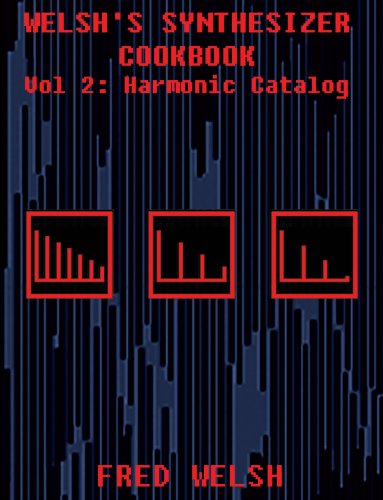
Welsh's Synthesizer Cookbook, Vol 2: Harmonic Catalog
Fred Welsh
Paperback - 130 pages& CD-ROM (July 2010)
Welsh's Synthesizer Cookbook, Vol. 2: Harmonic Catalog is intended for synthesizer players who have
either read Volume 1 (black and yellow cover) or are familiar with using harmonic analysis to program synths.
It contains over 230 frequency analysis graphs showing the harmonics of all the instruments in the orchestra,
808 and 909 drum machines, world instruments, vocals, sound effects and more. Using these graphs and the
included Fre(a)koscope analyzer it is possible to recreate these instruments with high precision. CD includes
Fre(a)koscope frequency analyzer VST plugin (Windows & Mac) as well as a full unlocked copy of the Lil' Devil
additive synthesizer VSTi (Windows only).
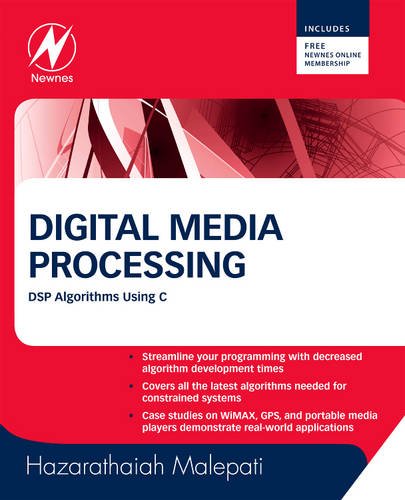
Digital Media Processing: DSP Algorithms Using C
Hazarathaiah Malepati
Paperback - 768 pages (June 2010)
Multimedia processing demands efficient programming in order to optimize functionality. Data, image,
audio, and video processing, some or all of which are present in all electronic devices today, are
complex programming environments. Optimized algorithms (step-by-step directions) are difficult to
create but can make all the difference when developing a new application.
This book discusses the most current algorithms available that will maximize your programming keeping
in mind the memory and real-time constraints of the architecture with which you are working. A wide
range of algorithms is covered detailing basic and advanced multimedia implementations, along with,
cryptography, compression, and data error correction. The general implementation concepts can be
integrated into many architectures that you find yourself working with on a specific project.
Analog Devices' BlackFin technology is used for examples throughout the book.
• Discusses how to decrease algorithm development times to streamline your programming
• Covers all the latest algorithms needed for constrained systems
• Includes case studies on WiMAX, GPS, and portable media players
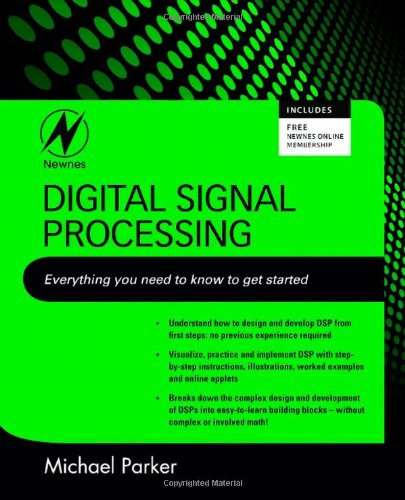
Digital Signal Processing 101: Everything you need to know to get started
Michael Parker
Paperback - 264 pages (April 2010)
DSP is utilized in just about every electronic system or device. DSP is taking one piece of information
be it data, image, video, or audio, most likely compressing, sending, and filtering it to another location
within your application to appear in the form of a document, picture or video.
Like Smith before it, this book is different to most on the market by following a popular applied approach
to this tricky subject, and will be the perfect starting point for engineers who need to get into DSP from
the ground floor. This book starts with the absolute basics of this integral process.
No experience is expected and with no prior knowledge taken for granted, a refresher chapter on complex
numbers and trigonometry can be found at the very beginning of the material. Real-world worked examples,
reference designs, and tools — including online applets that enable readers to visualize key
principles — complete a package that will help engineers who that needs to learn anew or refresh
their memory on this essential technology as they move to projects that require DSP familiarity.
• Dismayed when presented with a mass of equations as an explanation of DSP? This is the book for you!
• Clear examples and a non-mathematical approach gets you up to speed with DSP
• Includes an overview of the DSP functions and implementation used in typical DSP-intensive
applications, including error correction, CDMA mobile communication, and radar systems
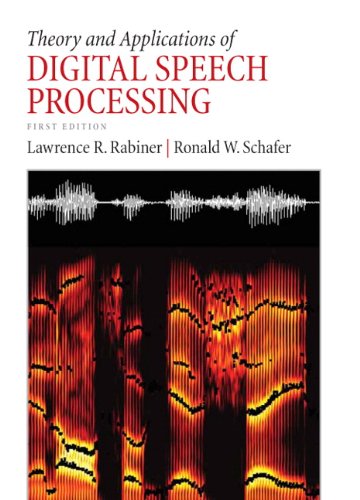
Theory and Applications of Digital Speech Processing
Lawrence Rabiner, Ronald Schafer
Hardcover - 1056 pages (March 2010)
Ideal for graduate students in digital signal processing and undergraduate students in Electrical
and Computer Engineering. With its clear, up-to-date, hands-on coverage of digital speech processing,
this text is also suitable for practicing engineers in speech processing.
This new text presents the basic concepts and theories of speech processing with clarity and currency,
while providing hands-on computer-based laboratory experiences for students. The material is organized
in a manner that builds a strong foundation of basics first, and then concentrates on a range of signal
processing methods for representing and processing the speech signal.
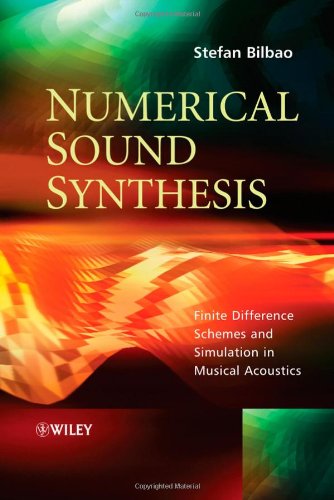
Numerical Sound Synthesis: Finite Difference Schemes and Simulation in Musical Acoustics
Stefan Bilbao
Hardcover - 456 pages (December 2009)
Digital sound synthesis has long been approached using standard digital filtering techniques.
Newer synthesis strategies, however, make use of physical descriptions of musical instruments,
and allow for much more realistic and complex sound production and thereby synthesis becomes a
problem of simulation. This book has a special focus on time domain finite difference methods
presented within an audio framework. It covers time series and difference operators, and basic
tools for the construction and analysis of finite difference schemes, including frequency-domain
and energy-based methods, with special attention paid to problems inherent to sound synthesis.
Various basic lumped systems and excitation mechanisms are covered, followed by a look at the
1D wave equation, linear bar and string vibration, acoustic tube modelling, and linear membrane
and plate vibration. Various advanced topics, such as the nonlinear vibration of strings and
plates, are given an elaborate treatment.
Key features:
• Includes a historical overview of digital sound synthesis techniques, highlighting the
links between the various physical modelling methodologies.
• A pedagogical presentation containing over 150 problems and programming exercises, and
numerous figures and diagrams, and code fragments in the MATLAB� programming language helps the
reader with limited experience of numerical methods reach an understanding of this subject.
• Offers a complete treatment of all of the major families of musical instruments, including
certain audio effects.
Numerical Sound Synthesis is suitable for audio and software engineers, and researchers in digital
audio, sound synthesis and more general musical acoustics. Graduate students in electrical engineering,
mechanical engineering or computer science, working on the more technical side of digital audio and
sound synthesis, will also find this book of interest.
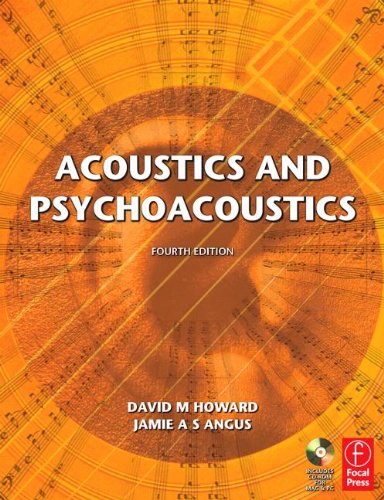
Acoustics and Psychoacoustics
David Howard, Jamie Angus
paperback 4th edition - 496 pages & CD (October 2009)
The acoustics of a space can have a real impact on the sounds you create and capture.
Acoustics and Psychoacoustics gives you an essential grounding and understanding
to how real music sounds behave in different spaces whether during a performance or a
recording and how they are perceived by performers and listeners. With their clear and
simple style Howard and Angus walk you through the theory — the science of sound
engineering and music production, the acoustics of musical instruments, how we hear
musical sounds, and the practical &mdah; how to apply it to music spaces to create
professional sound. Real-world examples and audio clips to work with are provided,
providing practical materials to work with. The new edition uncovers the acoustic
application for today's recording industry. The accompanying CD provides audio examples
to help readers gain a clear understanding of the many concepts discussed in the book.
The website is packed with audio clips, questions and answers, a calculation facility
as well as links and resources.
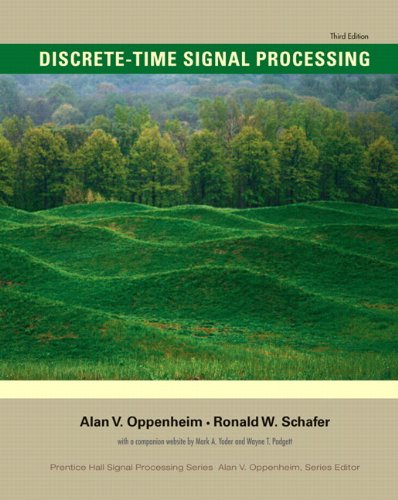
Discrete-Time Signal Processing
Alan V. Oppenheim, Ronald W. Schafer
Hardcover 3rd edition - 1120 pages (August 2009)
This is the standard text for introductory advanced undergraduate and first-year graduate level courses in
signal processing. The text gives a coherent and exhaustive treatment of discrete-time linear systems,
sampling, filtering and filter design, reconstruction, the discrete-time Fourier and z-transforms, Fourier
analysis of signals, the fast Fourier transform, and spectral estimation. The author develops the basic theory
independently for each of the transform domains and provides illustrative examples throughout to aid the
reader. Discussions of applications in the areas of speech processing, consumer electronics, acoustics,
radar, geophysical signal processing, and remote sensing help to place the theory in context. The text assumes
a background in advanced calculus, including an introduction to complex variables and a basic familiarity
with signals and linear systems theory. If you have this background, the book forms an up-to-date and self-contained
introduction to discrete-time signal processing that is appropriate for students and researchers. Discrete-Time
Signal Processing also includes an extensive bibliography.
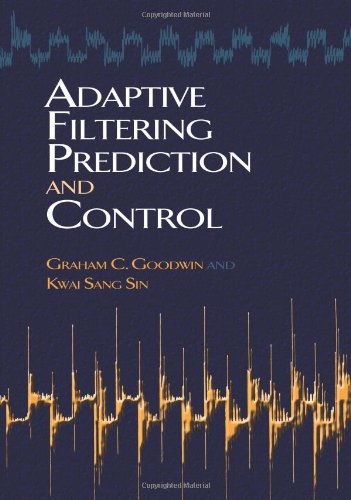
Adaptive Filtering Prediction and Control
Graham C Goodwin, Kwai Sang Sin
Paperback - 560 pages (May 2009)
This unified survey focuses on linear discrete-time systems and explores the natural extensions to
nonlinear systems. In keeping with the importance of computers to practical applications, the authors
emphasize discrete-time systems. Their approach summarizes the theoretical and practical aspects of a
large class of adaptive algorithms.
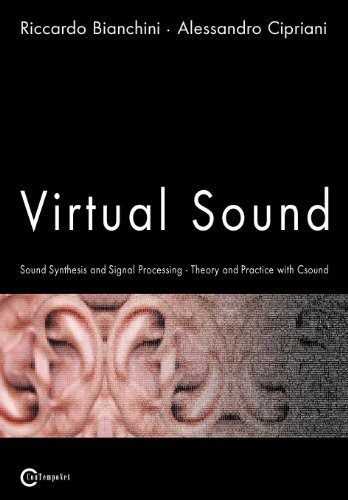
Virtual Sound — Sound Synthesis and Signal Processing — Theory and Practice with Csound
Riccardo Bianchini, Alessandro Cipriani
Paperback - 380 pages (December 2008)
Virtual Sound is an in-depth tutorial in computer music, complete with user-friendly
exercises in Csound that illustrate the theory and practice of each type of sound synthesis
and processing. The subjects covered include additive synthesis, subtractive synthesis,
flow-charts, control signals, vibrato and tremolo, 3-D sound, sampling, analysis and resynthesis,
MIDI files and MIDI controls, amplitude and ring modulation, frequency modulation (FM), echo,
reverberation, chorus, flanger, phaser, convolution, waveshaping and vector synthesis, granular
synthesis, formant synthesis, and physical modeling. If you have a basic understanding of computers
and the fundamentals of acoustics, you'll have no trouble reading this book. After having read it,
you should be able to use other commercial or research-oriented software with a greater understanding
of how it functions.
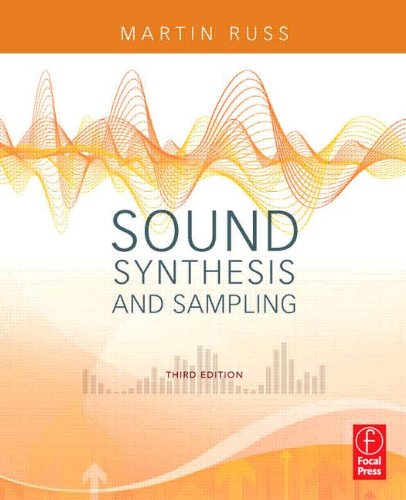
Sound Synthesis and Sampling
Martin Russ
Paperback 3rd edition - 568 pages (October 2008)
Sound Synthesis and Sampling provides a comprehensive introduction to the underlying principles and practical
techniques applied to both commercial and research sound synthesizers. This new edition has been updated throughout
to reflect current needs and practices- revised and placed in a modern context, providing a guide to the theory of
sound and sampling in the context of software and hardware that enables sound making. For the revised edition emphasis
is on expanding explanations of software and computers, new sections include techniques for making sound physically,
sections within analog and digital electronics. Martin Russ is well known and the book praised for its highly readable
and non-mathematical approach making the subject accessible to readers starting out on computer music courses or those
working in a studio.
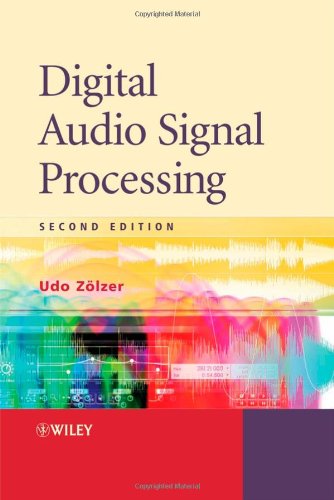
Digital Audio Signal Processing
Udo Zölzer
Hardcover 2nd edition - 340 pages (August 2008)
Well established in the consumer electronics industry, Digital Audio Signal Processing (DASP)
techniques are used in audio CD, computer music and multi-media components. In addition, the
applications afforded by this versatile technology now range from real-time signal processing
to room simulation.
Digital Audio Signal Processing, Second Edition covers the latest signal processing
algorithms for audio processing. Every chapter has been completely revised with an easy to
understand introduction into the basics and exercises have been included for self testing.
Additional Matlab files and Java Applets have been provided on an accompanying website, which
support the book by easy to access application examples.
Key features include:
• A thoroughly updated and revised second edition of the popular Digital Audio Signal
Processing, a comprehensive coverage of the topic as whole
• Provides basic principles and fundamentals for Quantization, Filters, Dynamic Range
Control, Room Simulation, Sampling Rate Conversion, and Audio Coding
• Includes detailed accounts of studio technology, digital transmission systems, storage
media and audio components for home entertainment
• Contains precise algorithm description and applications
• Provides a full account of the techniques of DASP showing their theoretical foundations
and practical solutions
• Includes updated computer-based exercises, an accompanying website, and features Web-based
Interactive Java Applets for audio processing.
This essential guide to digital audio signal processing will serve as an invaluable reference
to audio engineering professionals, R&D engineers, researchers in consumer electronics
industries and academia, and Hardware and Software developers in IT companies. Advanced students
studying multi-media courses will also find this guide of interest.
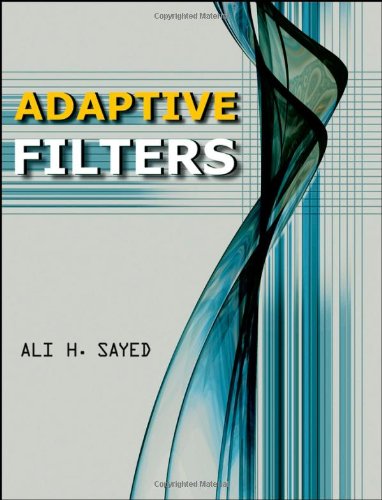
Adaptive Filters
Ali H. Sayed
Hardcover - 824 pages (April 2008)
Adaptive filtering is a topic of immense practical and theoretical value, having applications in areas
ranging from digital and wireless communications to biomedical systems. This book enables readers to gain
a gradual and solid introduction to the subject, its applications to a variety of topical problems, existing
limitations, and extensions of current theories. The book consists of eleven parts?each part containing a
series of focused lectures and ending with bibliographic comments, problems, and computer projects with
MATLAB solutions.
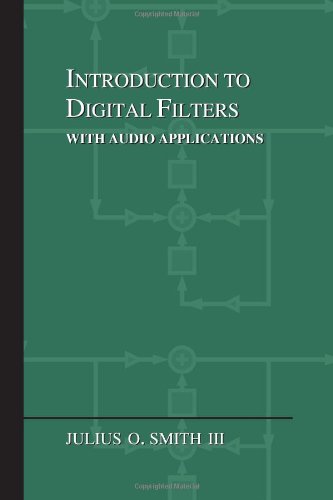
Introduction to Digital Filters: with Audio Applications
Julius O. Smith III
Paperback - 480 pages (October 2007)
A digital filter can be pictured as a "black box" that accepts a sequence of numbers and emits a
new sequence of numbers. In digital audio signal processing applications, such number sequences
usually represent sounds. For example, digital filters are used to implement graphic equalizers
and other digital audio effects. This book is a gentle introduction to digital filters, including
mathematical theory, illustrative examples, some audio applications, and useful software starting
points. The theory treatment begins at the high-school level, and covers fundamental concepts in
linear systems theory and digital filter analysis. Various �small� digital filters are analyzed as
examples, particularly those commonly used in audio applications. Matlab programming examples are
emphasized for illustrating the use and development of digital filters in practice.
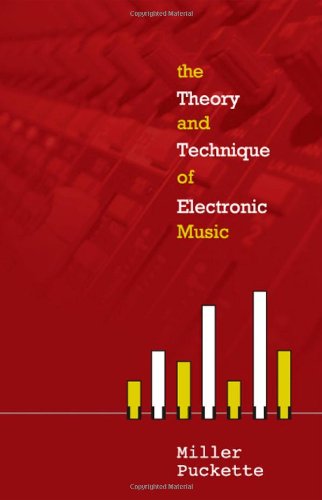
The Theory and Technique of Electronic Music
Miller Puckette
Hardcover - 348 pages (May 2007)
This is the first book to develop both the theory and the practice of synthesizing musical sounds
using computers. Each chapter starts with a theoretical description of one technique or problem
area and ends with a series of working examples (over 100 in all), covering a wide range of
applications. A unifying approach is taken throughout; chapter two, for example, treats both sampling
and wavetable synthesis as special cases of one underlying technique. Although the theory is presented
quantitatively, the mathematics used goes no further than trigonometry and complex numbers. The
examples and supported software along with a machine-readable version of the text are available on
the web and maintained by a large online community. The Theory and Techniques of Electronic Music
is valuable both as a textbook and as professional reading for electronic musicians and computer music
researchers.
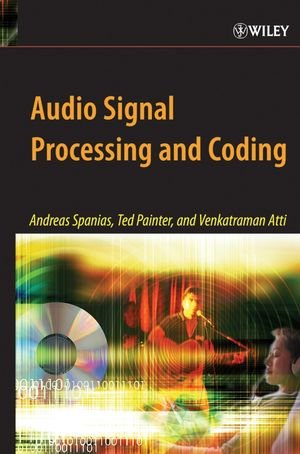
Audio Signal Processing and Coding
Andreas Spanias, Ted Painter, Venkatraman Atti
Hardcover - 464 pages (February 2007)
An in-depth treatment of algorithms and standards for perceptual coding of high-fidelity audio,
this self-contained reference surveys and addresses all aspects of the field. Coverage includes
signal processing and perceptual (psychoacoustic) fundamentals, details on relevant research and
signal models, details on standardization and applications, and details on performance measures
and perceptual measurement systems. It includes a comprehensive bibliography with over 600 references,
computer exercises, and MATLAB-based projects for use in EE multimedia, computer science, and DSP
courses.
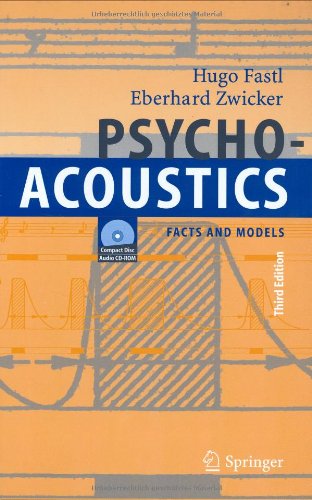
Psychoacoustics: Facts and Models
Hugo Fastl, Eberhard Zwicker
Hardcover 3rd edition - 474 pages (December 2006)
Psychoacoustics offers a unique, comprehensive summary of information describing the processing of
sound by the human hearing system. The third edition includes an additional chapter on audio-visual
interactions and applications, plus more on applications throughout.
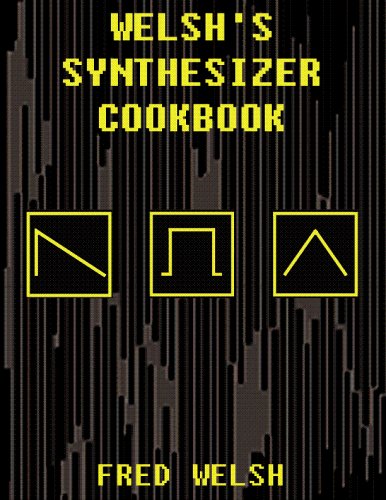
Welsh's Synthesizer Cookbook: Synthesizer Programming, Sound Analysis, and Universal Patch Book
Fred Welsh
Paperback - 128 pages & CD-ROM (November 2006)
This book covers ground that is often left untouched by other synthesizer books and was written to
fulfill the wishes voiced by synth programmers. Section one explains the parts of an analog synth in
detail using harmonic and waveform analysis to make clear exactly what each synth parameter does.
Section two is probably the most important section added to the new edition and it explains through
examples how to use freely available harmonic and waveform analysis software to analyze and recreate
patches from other synths, sounds found in songs, and the synthesis of acoustic instruments. Section
three contains all 102 of the original 1st and 2nd edition universal patches for ALL dual-oscillator
analog synths. The acoustic patches are based on harmonic analysis and are exceedingly close to the
real instruments. An included CD-ROM contains the new SCB VSTi softsynth and audio samples for
synthesizer calibration as well as a full album of electronica.
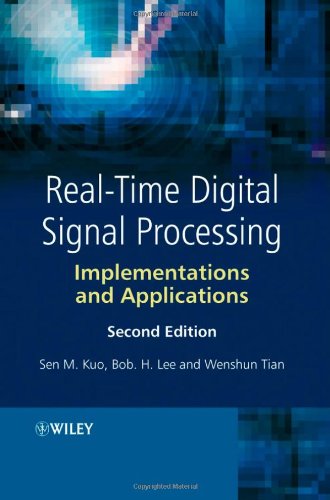
Real-Time Digital Signal Processing: Implementations and Applications
Sen M. Kuo, Bob H. Lee, Wenshun Tian
Hardcover 2nd edition - 664 pages (June 2006)
Completely updated and revised for the 2nd edition and remains the only book on DSP to provide
an overview of DSP theory and programming with hands-on experiments using MATLAB, C and the
newest fixed-point processors from Texas Instruments (TI).
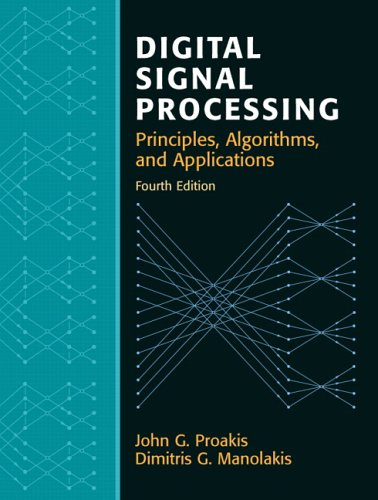
Digital Signal Processing
John G. Proakis, Dimitris K Manolakis
Hardcover 4th edition - 1004 pages (April 2006)
A significant revision of a best-selling text for the introductory digital signal processing course.
This book presents the fundamentals of discrete-time signals, systems, and modern digital processing
and applications for students in electrical engineering, computer engineering, and computer science.
The book is suitable for either a one-semester or a two-semester undergraduate level course in discrete
systems and digital signal processing. It is also intended for use in a one-semester first-year
graduate-level course in digital signal processing.
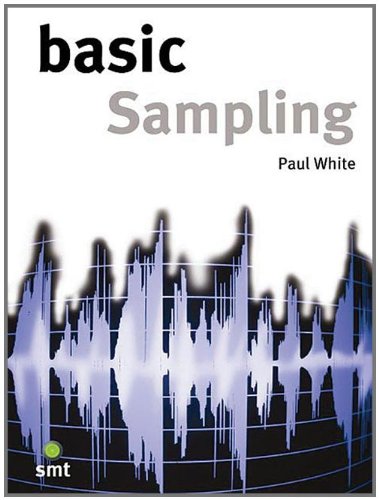
Basic Sampling
Paul White
Paperback - 224 pages (January 2006)
This book is a comprehensive and ready-to-go sampling solution. It covers all aspects of sampling:
choice of hardware equipment and software programs, setting up a sample capable recording system,
sourcing and recording from an audio sample, editing and manipulating audio samples, integration
of samples into music, and the most effective techniques and uses in sampling.
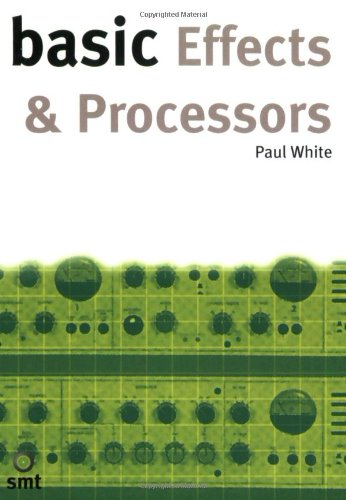
Basic Effects & Processors
Paul White
paperback - 208 pages (January 2006)
Modern music production relies heavily on effects and signal processing. This book uses simple language
to describe what effects are available, how they work and how they can be used effectively in music
production. Analogue, digital and software-based processing are also covered.
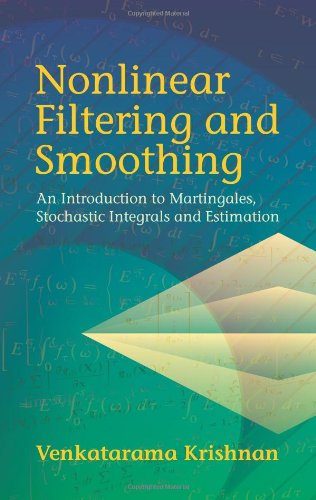
Nonlinear Filtering and Smoothing: An Introduction to Martingales, Stochastic Integrals and Estimation
Venkatarama Krishnan
Paperback - 336 pages (July 2005)
Appropriate for upper-level undergraduates and graduate students, this volume addresses the fundamental
concepts of martingales, stochastic integrals, and estimation. Written by an engineer for engineers, it
emphasizes applications. Many theorems feature heuristic proofs; others include rigorous proofs to
reinforce physical understanding. Numerous end-of-chapter problems enhance the book's practical value.
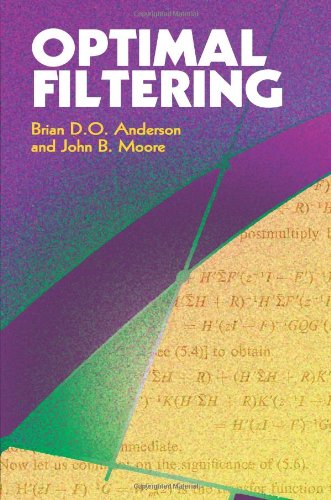
Optimal Filtering
Brian D.O. Anderson, John B. Moore
Paperback - 368 pages (January 2005)
This graduate-level text augments and extends studies of signal processing, particularly in regard to
communication systems and digital filtering theory. Topics include filtering, linear systems, and
estimation; the discrete-time Kalman filter; time-invariant filters; properties of Kalman filters;
computational aspects; smoothing of discrete-time signals; and more.
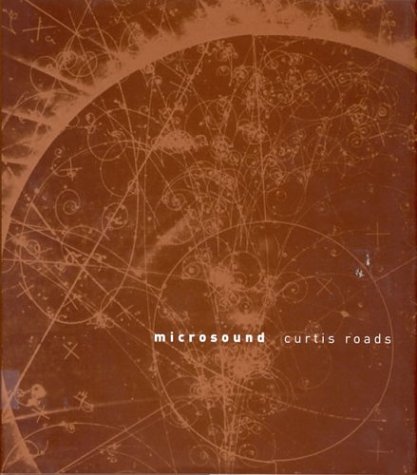
Microsound
Curtis Roads
Paperback - 423 pages & CD (August 2004)
Below the level of the musical note lies the realm of microsound, of sound particles lasting less
than one-tenth of a second. Recent technological advances allow us to probe and manipulate these
pinpoints of sound, dissolving the traditional building blocks of music — notes and their
intervals — into a more fluid and supple medium. The sensations of point, pulse (series of
points), line (tone), and surface (texture) emerge as particle density increases. Sounds coalesce,
evaporate, and mutate into other sounds.Composers have used theories of microsound in computer music
since the 1950s. Distinguished practitioners include Karlheinz Stockhausen and Iannis Xenakis. Today,
with the increased interest in computer and electronic music, many young composers and software
synthesis developers are exploring its advantages. Covering all aspects of composition with sound
particles, Microsound offers composition theory, historical accounts, technical overviews, acoustical
experiments, descriptions of musical works, and aesthetic reflections. The book is accompanied by an
audio CD of examples.
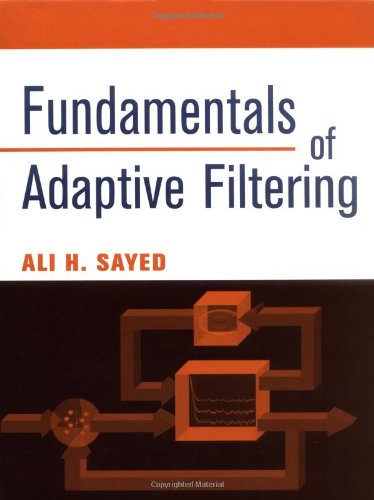
Fundamentals of Adaptive Filtering
Ali H. Sayed
Hardcover - 1168 pages (June 2003)
This book is based on a graduate level course offered by the author at UCLA and has been classed tested
there and at other universities over a number of years. This will be the most comprehensive book on the
market today providing instructors a wide choice in designing their courses. Offers computer problems to
illustrate real life applications for students and professionals alike
An Instructor's Manual presenting detailed solutions to all the problems in the book is available
from the Wiley editorial department.
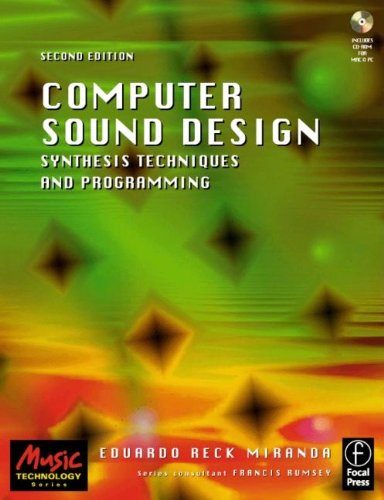
Computer Sound Design, Second Edition: Synthesis techniques and programming
Eduardo Miranda
Paperback 2nd edition - 263 pages & CD-ROM (December 2002)
This comprehensive introduction to software synthesis techniques and programming is intended for students,
researchers, musicians, sound artists and enthusiasts in the field of music technology.
The art of sound synthesis is as important for the electronic musician as the art of orchestration is
important for symphonic music composers. Those who wish to create their own virtual orchestra of electronic
instruments and produce original sounds will find this book invaluable. It examines a variety of synthesis
techniques and illustrates how to turn a personal computer into a powerful and flexible sound synthesiser.
The book also discusses a number of ongoing developments that may play an important role in the future of
electronic music making.
Previously published as Computer Sound Synthesis for the Electronic Musician, this second edition
features a foreword by Jean-Claude Risset and provides new information on:
• the latest directions in digital sound representation
• advances in physical modelling techniques
• granular and pulsar synthesis
• PSOLA technique
• humanoid voice synthesis
• artificial intelligence
• evolutionary computing.
The accompanying CD-ROM contains examples, complementary tutorials and a number of synthesis systems for
PC and Macintosh platforms, ranging from low level synthesis programming languages to graphic front-ends
for instrument and sound design. These include fully working packages, demonstration versions of commercial
software and experimental programs from top research centres in Europe, North and South America.
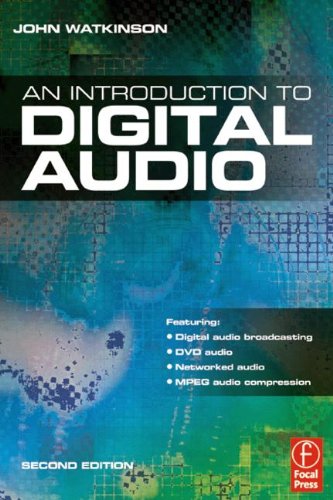
Introduction to Digital Audio
John Watkinson
Hardcover 2nd edition - 984 pages (November 2002)
Master the basics from first principles: the physics of sound, principles of hearing etc, then
progress onward to fundamental digital principles, conversion, compression and coding and then onto
transmission, digital audio workstations, DAT and optical disks. Get up to speed with how digital
audio is used within DVD, Digital Audio Broadcasting, networked audio and MPEG transport streams.
All of the key technologies are here: compression, DAT, DAB, DVD, SACD, oversampling, noise shaping
and error correction theories are treated in a simple yet accurate form.
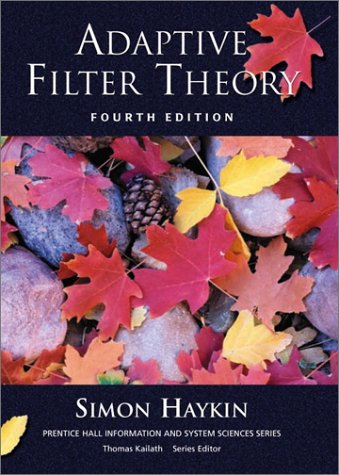
Adaptive Filter Theory
Simon O. Haykin
Paperback 4th edition - 936 pages (September 2001)
Haykin examines both the mathematical theory behind various linear adaptive filters and the elements
of supervised multilayer perceptrons. In its fourth edition, this highly successful book has been updated
and refined to stay current with the field and develop concepts in as unified and accessible a manner as
possible.
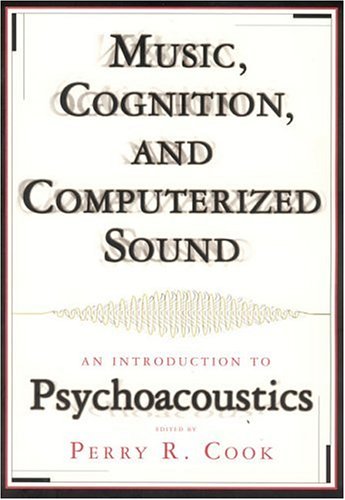
Music, Cognition, and Computerized Sound: An Introduction to Psychoacoustics
Perry R. Cook (Editor)
Paperback - 392 pages & CD (March 2001)
How hearing works and how the brain processes sounds entering the ear to provide the listener with
useful information are of great interest to psychologists, cognitive scientists, and musicians.
However, while a number of books have concentrated on individual aspects of this field, known as
psychoacoustics, there has been no comprehensive introductory coverage of the multiple topics
encompassed under the term. Music, Cognition, and Computerized Sound is the first book to
provide that coverage, and it does so via a unique and useful approach.The book begins with
introductory chapters on the basic physiology and functions of the ear and auditory sections of
the brain, then proceeds to discuss numerous topics associated with the study of psychoacoustics,
including cognitive psychology and the physics of sound. The book has a particular emphasis on music
and computerized sound. An accompanying audio CD includes many sound examples to help explicate the
text.The contributing authors include John Chowning, Perry R. Cook, Brent Gillespie, Daniel J. Levitin,
Max Mathews, John Pierce, and Roger Shepard.
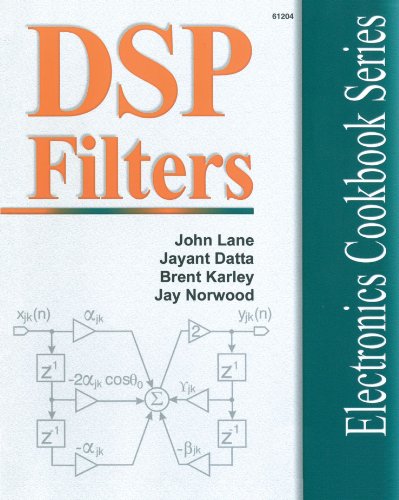
DSP Filter Cookbook
John Lane
Paperback - 352 pages (December 2000)
Digital filters and real-time processing of digital signals have traditionally been beyond the reach
of most, due partially to hardware cost as well as complexity of design. In recent years, low-cost
digital signal processor (DSP) development boards have put this within reach. This book will break
down this design complexity barrier by means of simplified tutorials, step-by-step instructions,
along with a collection of audio projects. Design formulas are presented to build the digital
equivalent of standard audio filters: lowpass, highpass, and bandpass.
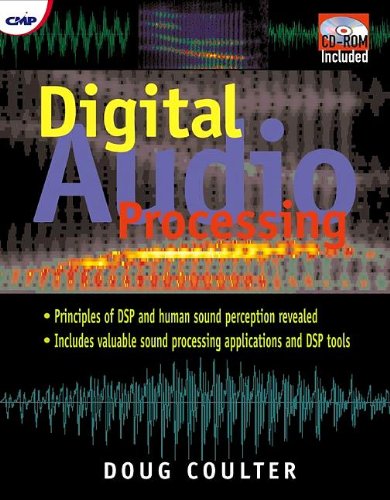
Digital Audio Processing
Doug Coulter
Paperback - 413 pages (April 2000)
Digital signal processing and human sound perception explained in accessible language! Includes
practical DSP programming tricks, techniques to compensate for acoustic and instrument limitations,
a treasure trove of C++ software tools for Windows 32-bit sound programming, and source code for
DSP and User Interface advancements for the WinTel platform.
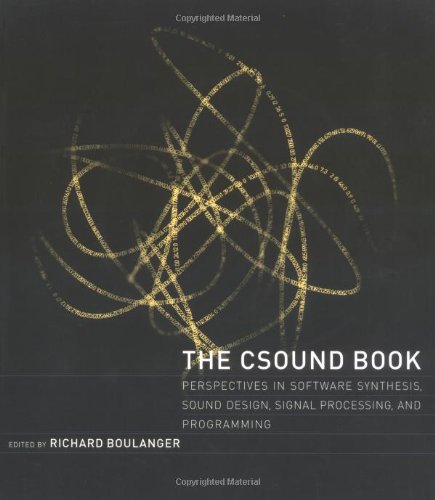
The Csound Book: Perspectives in Software Synthesis, Sound Design, Signal Processing, and Programming
Richard Boulanger (Editor)
Paperback - 782 pages (March 2000)
Created in 1985 by Barry Vercoe, Csound is one of the most widely used software sound synthesis
systems. Because it is so powerful, mastering Csound can take a good deal of time and effort. But
this long-awaited guide will dramatically straighten the learning curve and enable musicians to
take advantage of this rich computer technology available for creating music.
Written by the world's leading educators, programmers, sound designers, and composers, this
comprehensive guide covers both the basics of Csound and the theoretical and musical concepts
necessary to use the program effectively. The thirty-two tutorial chapters cover: additive,
subtractive, FM, AM, FOF, granular, wavetable, waveguide, vector, LA, and other hybrid methods;
analysis and resynthesis using ADSYN, LP, and the Phase Vocoder; sample processing; mathematical
and physical modeling; and digital signal processing, including room simulation and 3D modeling.
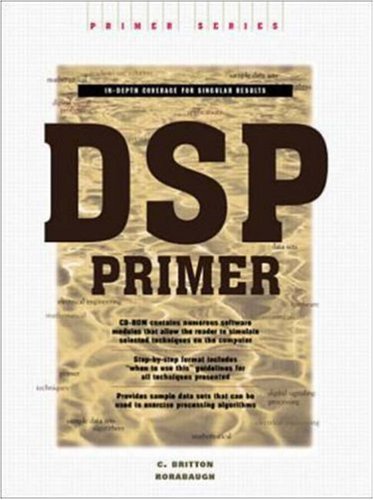
DSP Primer
C. Britton Rorabaugh
Hardcover - 560 pages & CD-ROM (October 1998)
Digital Signal Processing is one of the most explosive fields in all of Electrical Engineering with applications
in everything from telecommunications to computer hardware. Unlike most textbooks on the subject, this book
will not attempt to derive DSP techniques. Instead, this book provide nearly 200 mathematical methods, processing
algorithms, and design procedures in a clear, concise, step-by-step format so that the reader can quickly select
and implement an appropriate technique fro the problem at hand.
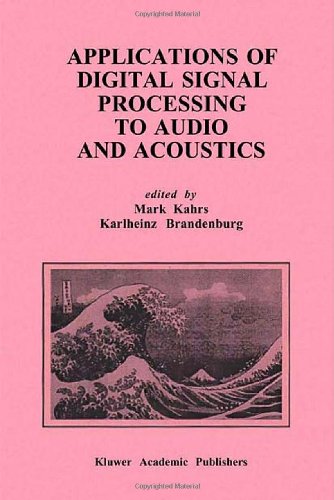
Applications of Digital Signal Processing to Audio and Acoustics
Mark Kahrs (Editor), Karlheinz Brandenburg (Editor)
Hardcover - 580 pages (March 1998)
With the advent of `multimedia', digital signal processing (DSP) of sound has emerged from the shadow
of bandwidth limited speech processing to become a research field of its own. To date, most research
in DSP applied to sound has been concentrated on speech, which is bandwidth limited to about 4 kilohertz.
Speech processing is also limited by the low fidelity typically expected in the telephone network. Today,
the main applications of audio DSP are high quality audio coding and the digital generation and manipulation
of music signals. They share common research topics including perceptual measurement techniques and
analysis/synthesis methods. Additional important topics are hearing aids using signal processing technology
and hardware architectures for digital signal processing of audio. In all these areas the last decade has
seen a significant amount of application-oriented research. The frequency range of wideband audio has an
upper limit of 20 kilohertz and the resulting difference in frequency range and Signal to Noise Ratio (SNR)
due to sample size must be taken into account when designing DSP algorithms. There are whole classes of
algorithms that the speech community is not interested in pursuing or using. These algorithms and techniques
are revealed in this book. This book is suitable for advanced level courses and serves as a valuable
reference for researchers in the field. Interested and informed engineers will also find the book useful
in their work.
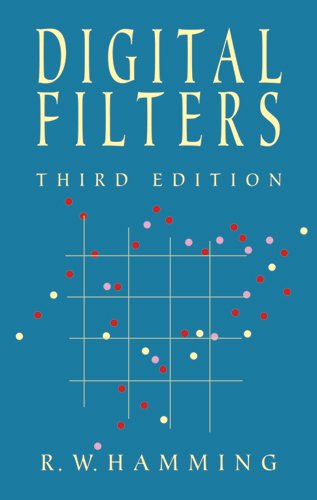
Digital Filters
Richard W. Hamming
Paperback - 296 pages (July 1997)
This introductory text examines digital filtering — the processes of refining signals
— and its relevance to many applications, particularly computer-related functions. Assuming
only a knowledge of calculus and some statistics, it concentrates on linear signal processing, with
some consideration of roundoff effects and Kalman filters. Numerous examples and exercises.
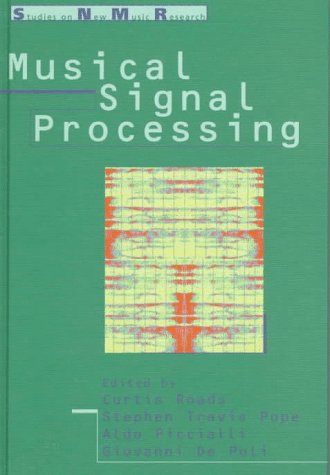
Musical Signal Processing
Curtis Roads (Editor), Stephen Travis Pope (Editor), Aldo Piccialli (Editor)
Hardcover - 492 pages (January 1997)
Compiled by an international array of musical and technical specialists, Musical Signal Processing opens
the door to the most important topics in musical signal processing today. Beginning with basic concepts,
and leading to advanced applications, it covers such essential areas as sound synthesis (including detailed
studies of physical modelling and granular synthesis), control signal synthesis, sound transformation
(including convolution), analysis/resynthesis (phase vocoder, wavelets, analysis by chaotic functions),
object-oriented and artificial intelligence representations, musical interfaces, and the integration of
signal processing techniques in concert performance.
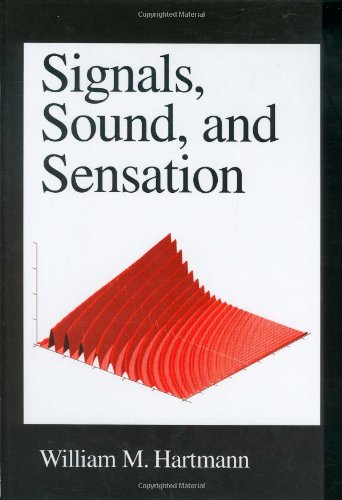
Signals, Sound, and Sensation
William M. Hartmann
Hardcover - 647 pages (January 1997)
Designed to follow an introductory text on psychoacoustics, this book takes readers through the mathematics
of signal processing from its beginnings in the Fourier transform to advanced topics in modulation, dispersion
relations, minimum phase systems, sampled data, and nonlinear distortion. While organised like an introductory
engineering text on signals, the examples and exercises come from research on the perception of sound. A unique
feature of this book is its consistent application of the Fourier transform, which unifies topics as diverse as
cochlear filtering and digital recording. More than 250 exercises are included, many of them devoted to practical
research in perception, while others explore surprising auditory illusions generated by special signals. Periodic
signals, aperiodic signals, and noise — along with their linear and nonlinear transformations — are
covered in detail. More advanced mathematical topics are treated in the appendices. A working knowledge of
elementary calculus is the only prerequisite. Indispensable for researchers and advanced students in the
psychology of auditory perception.
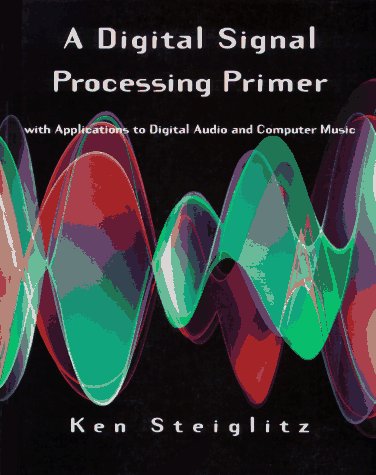
A Digital Signal Processing Primer: With Applications to Digital Audio and Computer Music
Ken Steiglitz
Paperback - 314 pages (April 1996)
Offers an informal and easy-to-understand introduction to digital signal processing, emphasizing digital audio and
applications to computer music. A DSP Primer covers important topics such as phasors and tuning forks; the
wave equation; sampling and quantizing; feedforward and feedback filters; comb and string filters; periodic
sounds; transform methods; and filter design. Steiglitz uses an intuitive and qualitative approach to develop the
mathematics critical to understanding DSP. A DSP Primer is written for a broad audience, including: Students of
DSP in Engineering and Computer Science courses Composers of computer music and those who work with digital sound
WWW and internet developers who work with multimedia General readers interested in science who want an
introduction to DSP Features Offers a simple and uncluttered step-by-step approach to DSP for first-time
users, especially beginners in computer music Designed to provide a working knowledge and understanding of
frequency-domain methods, including FFT and digital filtering Contains thought-provoking questions and
suggested experiments that help the reader understand and apply DSP theory and techniques.
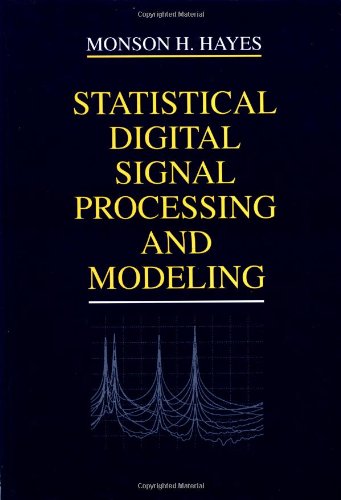
Statistical Digital Signal Processing and Modeling
Monson H. Hayes
Paperback - 624 pages (April 1996)
The main thrust is to provide students with a solid understanding of a number of important and related
advanced topics in digital signal processing such as Wiener filters, power spectrum estimation, signal
modeling and adaptive filtering. Scores of worked examples illustrate fine points, compare techniques
and algorithms and facilitate comprehension of fundamental concepts. Also features an abundance of
interesting and challenging problems at the end of every chapter.
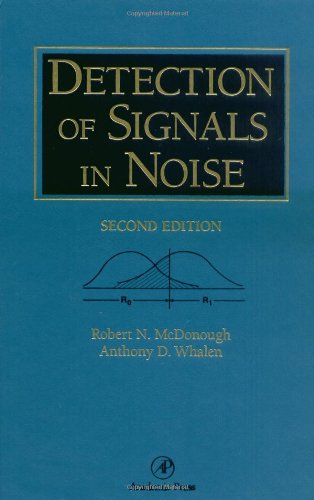
Detection of Signals in Noise
Robert N. McDonough, A.D. Whalen
Hardcover 2nd edition - 495 pages (May 1995)
The Second Edition is an updated revision to the authors highly successful and widely used introduction
to the principles and application of the statistical theory of signal detection. This book emphasizes
those theories that have been found to be particularly useful in practice including principles applied
to detection problems encountered in digital communications, radar, and sonar.
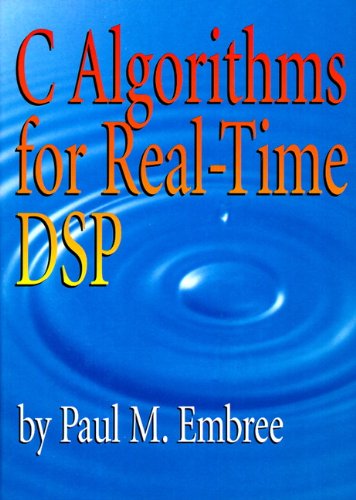
C Algorithms for Real-Time DSP
Paul M. Embree
Paperback - 256 pages (May 1995)
Digital signal processing techniques have become the method of choice in signal processing as digital
computers have increased in speed, convenience, and availability. At the same time, the C language is proving
itself to be a valuable programming tool for real-time computationally intensive software tasks. This book is a
complete guide to digital signal processing techniques in the C language. Covers the basic principles of digital
signal processing and C programming. Introduces the basic real-time DSP programming techniques and typical
programming environments which are used with DSP microprocessors. Covers the basic real-time filtering
techniques which are the cornerstone of one-dimensional real-time digital signal processing. For electrical
engineers and computer scientists.
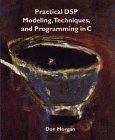
Practical DSP Modeling, Techniques, and Programming in C
Don Morgan
Paperback - 442 pages (December 1994)
Most DSP texts are long on theory and short on practical programming solutions. Here, at last, is a book
that fully bridges the gap between DSP theory and real-world applications. Whether you are a programmer
or engineer working in telecommunications, entertainment, aerospace, or any of the multitude of scientific
or commercial fields in which digital signal processing is coming to play an ever more vital role, this book
provides you with all the basic information and practical nuts-and-bolts guidance you need to use this exciting
technology without having to first school (or reschool) yourself in all the abstruse theoretical issues and
high-level mathematics behind it.
A wide range of real-world examples from many areas of engineering and detailed illustrations of points covered
• In-depth explanations of state-of-the-art hardware, as well as detailed circuit and design information
for the most popular filter types
• Instructions on how to build your own data acquisition board, DACQ, from scratch or from a kit
• All crucial DSP algorithms explained from "the ground up"
• Features a variety of projects and working applications that you can reproduce and run on your computer.
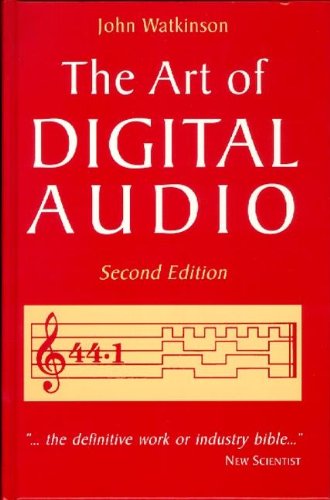
The Art of Digital Audio
John Watkinson
Hardcover 2nd edition - 685 pages (January 1994)
Pulls various technologies together as they relate to audio. It deals with advanced topics, theory and a whole
new world of practical implementation. Because of the fast moving nature of the technology described in the
book the new edition includes more information on the AES/EBU interface, DCC, NAGRA and data reduction as well
as Digital Audio Broadcasting.
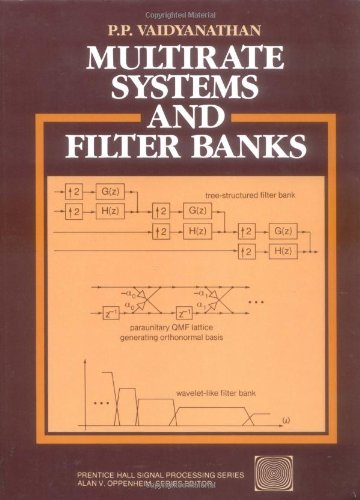
Multirate Systems And Filter Banks
P.P. Vaidyanathan
Paperback - 911 pages (October 1992)
Presenting general principles without bias towards specific application-oriented detail, this text offers
a thorough, unified, and in-depth treatment of the techniques of multirate signal processing. It is the
first book to cover the topics of digital filter banks, multidimensional multirate systems, and wavelet
representations under one cover. This manual will be valuable to engineers working with applications of
speech and image compression, digital audio, and statistical and adaptive signal processing.
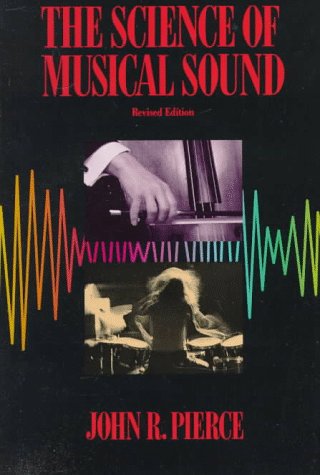
The Science of Musical Sound
John Robinson Pierce
Paperback - 270 pages (May 1992)
Behind the creation of any musical sound lie the complex processes of physics, electronics, mathematics,
and human perception. The interplay of these factors is the focus of John R. Pierce's
The Science of Musical Sound, revised edition — a volume that covers the production of a
single drumbeat and the wizardry of the latest recording and synthesizing techniques to explore where
sound comes from and how we recognize and enjoy it as music. In The Science of Musical Sound,
John Pierce combines an explanation of the physics of musical instruments with a review of the principles
of psychoacoustics. The latest research findings and Pierce's own firsthand experiences and insights
inform the book's survey of the many aspects of this multifaceted field-including the physical and
mathematical properties of sound waves, the relationship of sound to music, the physical correlates of
consonance and harmony, the phenomena of hearing and sound perception, architectural acoustics, and
much more. Pierce measures the farreaching impact of the past decade's technological revolution by
charting the emergence of computers in music, compact discs, and digital recording and synthesizing.
He also looks ahead to the surprising, evolving MIDI Standard that can link any keyboard to a digital
synthesizer.
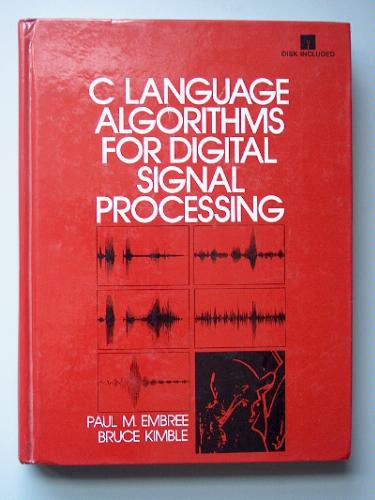
C Language Algorithms for Digital Signal Processing
Paul Embree, Bruce Kimball
Hardcover - 933 pages (January 1991)
This book explains how to write C programs that manipulate digital signal processors (DSPs). Signal
processing components can be programmed to perform a wide variety of functions with the handbook's
advice. It offers step-by-step techniques covering: filtering routines, user interfaces and storage,
discrete Fourier transforms, matrix and vector analysis, and more.
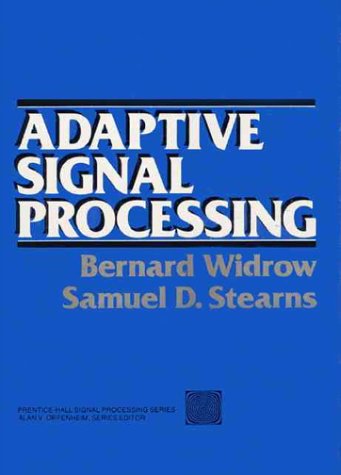
Adaptive Signal Processing
Bernard Widrow, Peter N. Stearns
Paperback - 528 pages (March 1985)
A comprehensive and practical treatment of adaptive signal processing featuring frequent use of examples.

